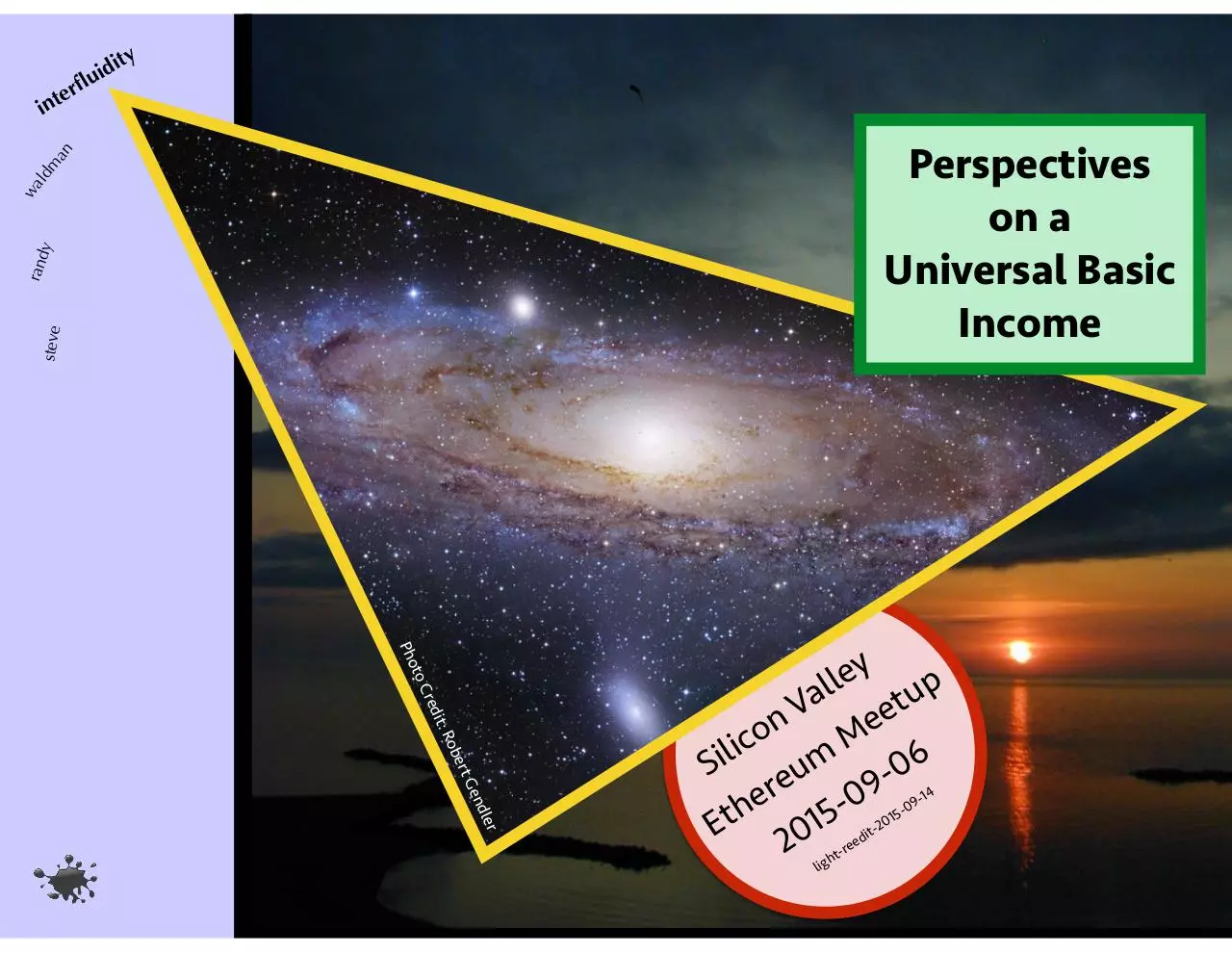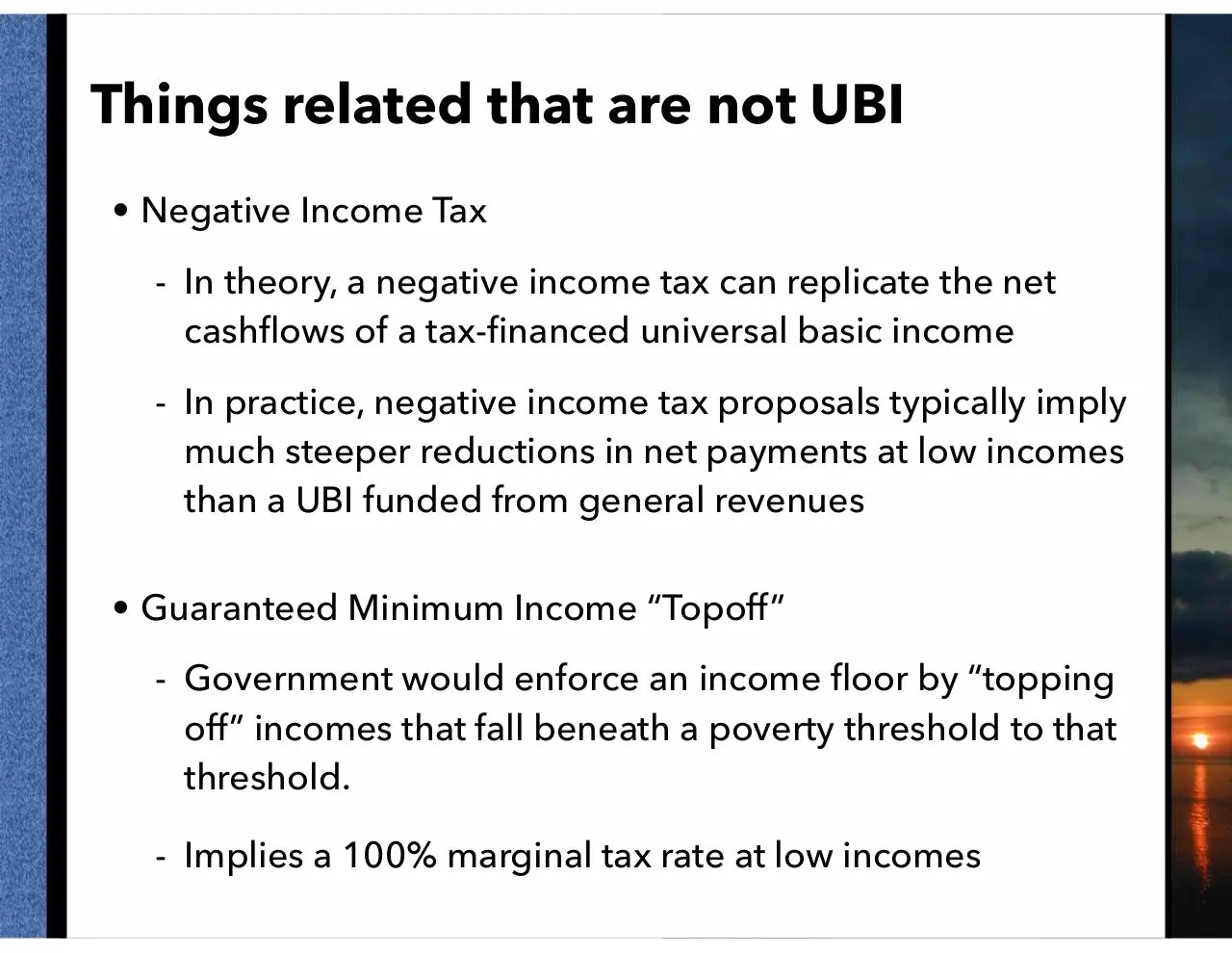Perspectives On Universal Basic Income (PDF)
File information
This PDF 1.3 document has been generated by Keynote / Mac OS X 10.10.5 Quartz PDFContext, and has been sent on pdf-archive.com on 25/09/2015 at 11:18, from IP address 178.73.x.x.
The current document download page has been viewed 461 times.
File size: 3.19 MB (50 pages).
Privacy: public file





File preview
ty
idi
u
fl
er
int
steve
rand
y
wa
ld
m
an
Perspectives
on a
Universal Basic
Income
ler
end
tG
r
obe
t: R
i
red
to C
Pho
ey
l
p
l
u
a
t
V
e
n
e
o
M 6
ic
l
i
m
S
u
-0
e
9
r
e
0
h
5
t
1
E
0
2
4
9-1
i
ed
lig
-re
ht
5-0
01
2
t
What is a Universal Basic Income (UBI)?
• The simplest thing…
- everybody gets a regular check, in identical amounts,
just for breathing.
• Nothing is that simple…
- “everybody” demands a definition. kids? dogs?
citizens? legal residents? felons? and who’s paying
for all this?
• Sure…
- those are important questions, on which more later.
but really, this is pretty simple.
Things related that are not UBI
• Negative Income Tax
- In theory, a negative income tax can replicate the net
cashflows of a tax-financed universal basic income
- In practice, negative income tax proposals typically imply
much steeper reductions in net payments at low incomes
than a UBI funded from general revenues
• Guaranteed Minimum Income “Topoff”
- Government would enforce an income floor by “topping
off” incomes that fall beneath a poverty threshold to that
threshold.
- Implies a 100% marginal tax rate at low incomes
Perspectives on a UBI
- Fixed/floating swap on highly variable income
- Improved worker bargaining power without restricting
flexibility
- A better antipoverty program
- A sociotechnological dividend
- VC for the people
- Hayekian investment subsidy
- Escaping the macroeconomic floor to prevent “secular
stagnation”
- An instrument of socioeconomic cohesion
Side note: Paying for a UBI
• In monetary terms, a UBI, like any other form of government
expenditure, would be paid for by some mix of taxation,
borrowing, monetization, and reduction of other spending.
• Thinking in terms of “dollars & cents” is misleading and
incomplete with respect to government finance.
- Actual constraints on government finance are
+ Uncomfortable tradeoffs between inflation and high
interest rates
+ Valuation uncertainty associated with the possibility of
“runs” on cash and government debt
- These constraints depend on the target, scale, source of
finance, and distribution of expenditure
Side note: Paying for a UBI
• It is conventional to declare a program “funded” if new
dollars taxed or recovered through reduction of other
expenditures matches the cost of a program, implying no
need for new borrowing or monetization.
• Like most conventions, this one is adopted because it is
simple, not because it is true.
Example: Consider a 4% surtax on incomes over $5M per year.
20% of the proceeds are used to pay off debt while 80% is used
to fund school construction. This program would most likely be
inflationary at the margin, despite reducing the Federal debt,
because much of the income taxed would otherwise have been
saved in financial instruments very loosely coupled to real
spending, while the 80% spent would all bid for real goods and
services.
Side note: Paying for a UBI
• A dollar of UBI spending is likely to be less inflationary than
a dollar’s worth of direct government spending, but more
inflationary than a dollar’s worth of foregone Federal
Income Tax revenue or foregone “tax
expenditures” (embedded in tax deductions for mortgage
interest, charitable donations, etc).
• A dollar of UBI spending is likely to be similarly inflationary
to spending on government transfer programs like social
security.
• A UBI “fully funded” from Federal Income Tax alone would
likely be net inflationary.
• A UBI “fully funded” in large part by replacement of other
transfer programs would likely be close to neutral.
Side note: Paying for a UBI
• A “fully funded” UBI would likely to reduce valuation
uncertainty / vulnerability to runs of currency and
government debt.
• Unless otherwise noted, we will assume a UBI “fully funded”
by reductions of alternative transfer programs and increased
taxation, and presume this will be neither inflationary nor
deflationary.
• However, sometimes “net inflationary” is a desideratum
rather than a constraint.
• In disinflationary times, adjustments of the level and source
of finance of a UBI can provide “fiscal stimulus” with unusual
transparency and fairness, i.e. with little potential for
corruption or “make work”. (More on this later.)
Fixed/floating swap on variable income
• UBI is often understood as a form of redistribution.
Everybody gets the same “basic income”, but the poor pay
very little for that in taxes while the rich pay much more in
taxes than they receive.
• But UBI is first and foremost an insurance program. It would
be desirable even in a world where all individuals start-off
with identical but uncertain prospects for future wealth and
income.
• In financial terms, in a world with ex ante identical agents,
UBI would be a pure fixed/floating swap. Each individual’s
future income (from labor earnings, investment, etc) is
uncertain and variable, much more variable than aggregate
production of the entire economy.
Download Perspectives On Universal Basic Income
Perspectives On Universal Basic Income.pdf (PDF, 3.19 MB)
Download PDF
Share this file on social networks
Link to this page
Permanent link
Use the permanent link to the download page to share your document on Facebook, Twitter, LinkedIn, or directly with a contact by e-Mail, Messenger, Whatsapp, Line..
Short link
Use the short link to share your document on Twitter or by text message (SMS)
HTML Code
Copy the following HTML code to share your document on a Website or Blog
QR Code to this page

This file has been shared publicly by a user of PDF Archive.
Document ID: 0000303391.